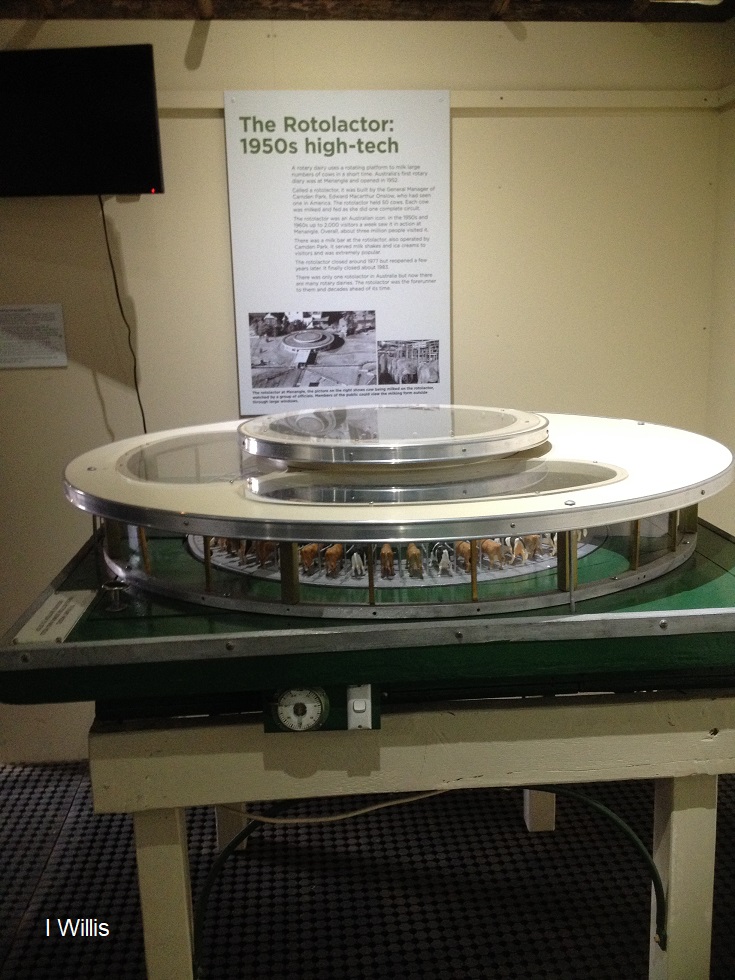A rotating wonder
One of the largest tourist attractions in the local area in the mid-20th century was a local milking marvel known as the Rotolactor.
Truly a scientific wonder, the Rotolactor captured people’s imagination at a time when scientific marvels instilled excitement in the general public.
In these days of post-modernism and fake news, this excitement seems hard to understand.

What was the Rotolactor?
The Rotolactor was an automated circular milking machine with a rotating platform introduced into the Camden Park operation in 1952 by Edward Macarthur Onslow from the USA.
Part of agricultural modernism, the Rotolactor was installed by the Macarthur family on their colonial property of Camden Park Estate to improve their dairying operations in the mid-20th century.
The idea of a rotating milking platform was American and first introduced in New Jersey in the mid-1920s.

The 1940s manager of Camden Park, Lieutenant-Colonel Edward Macarthur Onslow, inspected an American Rotolactor while overseas on a business trip and returned to Australia full of enthusiasm to build one at Camden Park.
The Menangle Rotolactor was the first in Australia and only the third of its kind in the world.

The rotating dairy could milk 1,000 cows twice a day. It held 50 cows at a time and was fed at as they were milked. The platform rotated about every 12 minutes.
The Rotolactor was a huge tourist attraction for Menangle village and provided many local jobs.
In 1953 it was attracting 600 visitors on a weekend, with up to 2000 visitors a week at its peak. (The Land, 27 March 1953)
Town planning disruption
In 1968 town planning disrupted things. The Askin state government released the Sydney Regional Outline Plan, followed by the 1973 New Cities of Campbelltown Camden Appin Structure Plan, which later became the Macarthur Growth Centre in 1975.
The structure plan did recognise the importance of the Rotolactor and the cultural heritage of the Menangle village. (The State Planning Authority of New South Wales, 1973, p. 84)
These events, combined with declining farming profits, encouraged the Macarthur family to sell out of Camden Park including the Rotolactor and the private village of Menangle.
The Rotolactor continued operations until 1977 and then remained unused for several years. It was then purchased by Halfpenny dairy interests from Menangle, who operated the facility until it finally closed in 1983. (Walsh 2016, pp.91-94)
Community festival celebrates the Rotolactor
In 2017 the Menangle Community Association organised a festival to celebrate the history of the Rotolactor. It was called the Menangle Milk-Shake Up and was a huge success.

The Festival exceeded all the expectations of the organisers from the Menangle Community Association when it attracted over 5000 people to the village from all over Australia. (Wollondilly Advertiser, 18 September 2017)
The Menangle Community Association Facebook page described it this way:
A true country event like in the old days. So many visitors came dressed up in their original 50s clothes, and all those wonderful well selected stall holders. It was pure joy.
Despite these sentiments, the event just covered costs (Wollondilly Advertiser, 5 April 2018)
The festival’s success was a double-edged sword for the organisers from the Menangle Community Association.
Urban development
The festival’s success demonstrated to local development interests that Rotolactor nostalgia could be marketized and had considerable commercial potential.
The Menangle Community Association attempted to lift the memory of the Rotolator and use it as a weapon to protect the village from the forces of urban development and neo-liberalism
Menangle land developers also used the festival’s success to further their interests.
Developer Halfpenny made numerous public statements supporting the restoration of the Rotolactor as a function centre and celebrating its past. (The Sydney Morning Herald, 22 December 2017).

The newspaper article announced that the site’s owner, local developer Ernest Dupre of Souwest Developments, has pledged to build a micro-brewery, distillery, two restaurants, a farmers market, a children’s farm, a vegetable garden, and a hotel with 30 rooms.
In 2017 the state government planning panel approved the re-zoning of the site for 350 houses and a tourist precinct. Housing construction will be completed by Mirvac.
Mr Dupre stated that he wanted to turn the derelict Rotolactor into a function with the adjoining Creamery building as a brewery next to the Menangle Railway Station.
He expected the development to cost $15 million and take two years. The plan includes an outdoor concert theatre for 8000 people and a lemon grove.
Facebook Comments 6 August 2021
Reply as Camden History Notes
- Bev WatersonRemember it well. My parents would take us there quite regularly.
JD GoreyThanks Elizabeth Searle ! I’ll show him! He’ll be interested for sure!! ![]()
Elizabeth SearleJD Gorey, The pilot was asking about this during our trip to the farm. He may be interested in the article ![]() Originally posted 19 July 2019. Updated 6 April 2021.
Originally posted 19 July 2019. Updated 6 April 2021.
- Lynette RichardsonRemember it well1
- Jan CarbisWent there all the time growing up. Such an interesting place.
- Sheree Ann BruceJan Carbis it was great wasn’t it
- Jan CarbisSheree Ann Bruce it so was. Spent hours there.
- Sheree Ann BruceJan Carbis yes we did too loved it
Facebook comments 9 May 2023
- Craige Cole I remember travelling from our family dairy farm on the far south coast to visit the Rotalactor in the late 60s and recall the total awe of my parents. I know that visit was the catalyst for us installing a new more efficient dairy setup.
- Caroline TavendaleCraige Cole our friends own a dairy farm in Rochester, Victoria. They have rotolactor dairy, installed it about 3 years ago.
- Julie ClarkeMy dad worked on the rotolactor.
- Cheryl RawlinsonLoved the milkshakes
Updated 9 May 2023. Originally posted on 19 July 2019.


















You must be logged in to post a comment.